
Emmeline Pankhurst was a British political activist who organised the British suffragette movement and helped women to win in 1918 the right to vote in Great Britain and Ireland. In 1999, Time named her as one of the 100 Most Important People of the 20th Century, stating that "she shaped an idea of objects for our time" and "shook society into a new pattern from which there could be no going back". She was widely criticised for her militant tactics, and historians disagree about their effectiveness, but her work is recognised as a crucial element in achieving women's suffrage in the United Kingdom.

Dame Christabel Harriette Pankhurst was a British suffragette born in Manchester, England. A co-founder of the Women's Social and Political Union (WSPU), she directed its militant actions from exile in France from 1912 to 1913. In 1914, she supported the war against Germany. After the war, she moved to the United States, where she worked as an evangelist for the Second Adventist movement.

The Women's Social and Political Union (WSPU) was a women-only political movement and leading militant organisation campaigning for women's suffrage in the United Kingdom founded in 1903. Known from 1906 as the suffragettes, its membership and policies were tightly controlled by Emmeline Pankhurst and her daughters Christabel and Sylvia. Sylvia was eventually expelled.

Adela Constantia Mary Walsh was a British-born suffragette who worked as a political organiser for the Women's Social and Political Union (WSPU) in Scotland. In 1914 she moved to Australia where she continued her activism and was co-founder of both the Communist Party of Australia and the Australia First Movement.

A suffragette was a member of an activist women's organisation in the early 20th century who, under the banner "Votes for Women", fought for the right to vote in public elections in the United Kingdom. The term refers in particular to members of the British Women's Social and Political Union (WSPU), a women-only movement founded in 1903 by Emmeline Pankhurst, which engaged in direct action and civil disobedience. In 1906, a reporter writing in the Daily Mail coined the term suffragette for the WSPU, derived from suffragistα, in order to belittle the women advocating women's suffrage. The militants embraced the new name, even adopting it for use as the title of the newspaper published by the WSPU.
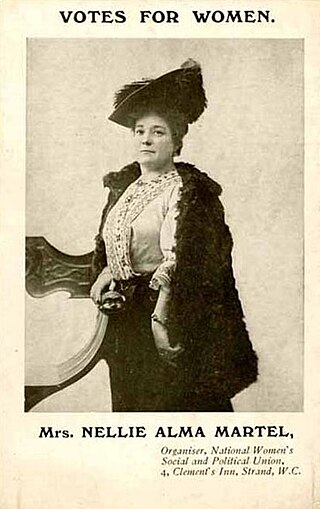
Ellen Alma Martel, was an English-Australian suffragist and elocutionist. She stood for the Senate at the 1903 federal election, one of the first four women to stand for federal parliament.

The Emmeline and Christabel Pankhurst Memorial is a memorial in London to Emmeline Pankhurst and her daughter Christabel, two of the foremost British suffragettes. It stands at the entrance to Victoria Tower Gardens, south of Victoria Tower at the southwest corner of the Palace of Westminster. Its main feature is a bronze statue of Emmeline Pankhurst by Arthur George Walker, unveiled in 1930. In 1958 the statue was relocated to its current site and the bronze reliefs commemorating Christabel Pankhurst were added.
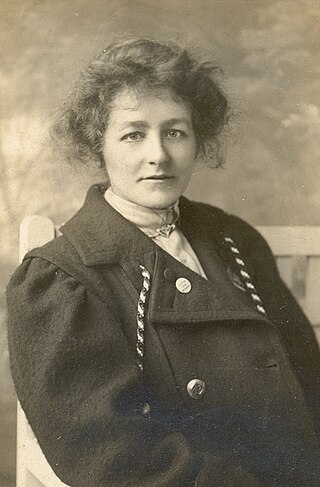
Edith Bessie New was an English suffragette who was one of the first two suffragettes to use vandalism as a tactic. She and Mary Leigh were surprised to find their destruction was celebrated, and they were pulled triumphantly by lines of suffragettes on their release from prison in 1908.

Mary Elizabeth Phillips was an English suffragette, feminist and socialist. She was the longest prison serving suffragette. She worked for Christabel Pankhurst but was sacked; she then worked for Sylvia Pankhurst as Mary Pederson or Mary Paterson. In later life she supported women's and children's organisations.

Elizabeth Watson was a Scottish child suffragette and piper.

Women's Sunday was a suffragette march and rally held in London on 21 June 1908. Organised by Emmeline Pankhurst's Women's Social and Political Union (WSPU) to persuade the Liberal government to support votes for women, it is thought to have been the largest demonstration to be held until then in the country.

Lillian Dove-Willcox (1875–1963) was a British suffragette who was a member of Emmeline Pankhurst's personal bodyguard.

Edith Hudson was a British nurse and suffragette. She was an active member of the Edinburgh branch of the Women's Social and Political Union (WSPU) and was arrested several times for her part in their protests in Scotland and London. She engaged in hunger strikes while in prison and was forcibly fed. She was released after the last of these strikes under the so-called Cat and Mouse Act. Hudson was awarded a Hunger Strike Medal 'for Valour' by the WSPU.

Jane Sbarborough also known as Sbarabara, was born in Canada East but is recognized as a British suffragette. She, along with Annie Kenney and Adelaide Knight, was part of the "Canning Town Three", as dubbed by the press. Sbarborough was an early member of the first East End London branch of the Women's Social and Political Union.
Katherine "Kitty" Marshall was a British suffragette known for her role in the militant Women's Social and Political Union and as one of the bodyguard for the movement's leaders who had been trained in ju-jitsu.

Eleanor Grace Watney Roe was Head of Suffragette operations for the Women's Social and Political Union. She was released from prison after the outbreak of World War I due to an amnesty for suffragettes negotiated with the government by the WSPU.

Minnie Turner was a British suffragette who was known for running a guest house, the "Sea View", in Brighton. In November 1911 she was arrested for breaking a window in the Home Office for which she received a 21 day sentence Holloway Prison.
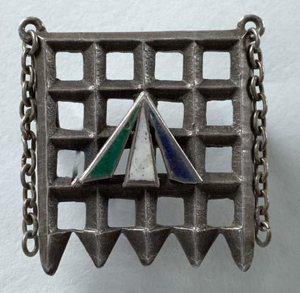
The Holloway brooch was presented by the Women's Social and Political Union (WSPU) to women who had been imprisoned at Holloway Prison for militant suffragette activity. It is also referred to as the "Portcullis badge", the "Holloway Prison brooch" and the "Victoria Cross of the Union".
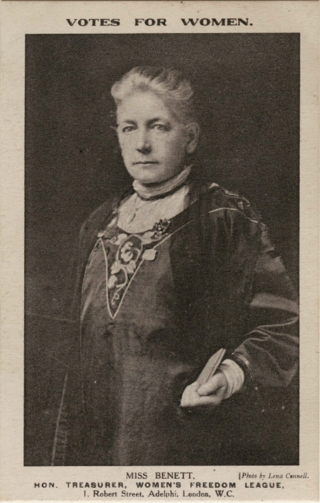
Sarah Barbara Benett was a suffragette, a member of the Women's Social and Political Union (WSPU) and Treasurer of the Women's Freedom League (WFL). She was one of the "Brown Women" who walked from Edinburgh to London in 1912 and went on hunger strike during her imprisonment in Holloway Prison for which she received the WSPU's Hunger Strike Medal and Holloway brooch.
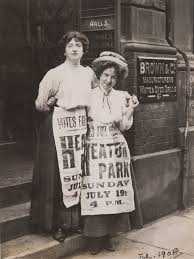
Patricia Woodlock was a British artist and suffragette who was imprisoned seven times, including serving the longest suffragette prison sentence in 1908 ; she was awarded a Women's Social and Political Union (WSPU) Hunger Strike Medal for Valour. Her harsh sentence caused outrage among supporters and inspired others to join the protests. Her release was celebrated in Liverpool and London and drawn as a dreadnought warship, on the cover of the WSPU Votes for Women newspaper.





















